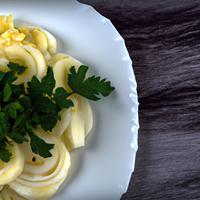
1 serving (100 grams) contains 42 calories, 1.5 grams of protein, 0.3 grams of fat, and 9.2 grams of carbohydrates.

Log this food in SnapCalorie

Nutrition Information
Calories |
100 | ||
|---|---|---|---|
% Daily Value* |
|||
| Total Fat | 0.7 g | 0% | |
| Saturated Fat | 0.2 g | 1% | |
| Polyunsaturated Fat | 0 g | ||
| Cholesterol | 0 mg | 0% | |
| Sodium | 238.1 mg | 10% | |
| Total Carbohydrates | 21.9 g | 7% | |
| Dietary Fiber | 4.3 g | 15% | |
| Sugars | 3.8 g | ||
| protein | 3.6 g | 7% | |
| Vitamin D | 0 mcg | 0% | |
| Calcium | 102.4 mg | 7% | |
| Iron | 1.7 mg | 9% | |
| Potassium | 714.3 mg | 15% | |
* Percent Daily Values are based on a 2,000 calorie diet. Your daily values may be higher or lower depending on your calorie needs.
Food Attributes
Source of Calories
About Celeraiac
Celeriac, also known as celery root, is a knobby, brown vegetable with a mild, earthy flavor and creamy white interior. Native to the Mediterranean and popular in European cuisines, it’s prized for its versatility in soups, salads, mashes, and gratins. Celeriac is low in calories while being rich in fiber, vitamin C, and vitamin K, supporting immunity, bone health, and digestion. Its potassium content aids in maintaining healthy blood pressure levels. Though it contains natural sugars, its glycemic index is relatively low, making it suitable for most diets. Celeriac also provides antioxidants, such as apigenin, which may help combat inflammation. However, individuals with celery allergies should avoid it, as the two are closely related. A healthy, flavorful alternative to starchy vegetables, celeriac is an excellent addition to a nutrient-conscious kitchen.



